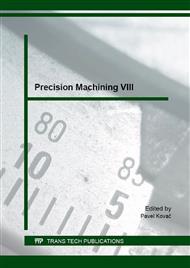p.125
p.131
p.137
p.143
p.149
p.155
p.161
p.168
p.174
Aluminum-Based MMC Machining with Carbide Cutting Tool
Abstract:
Cutting of metal matrix composites (MMCs) has been considerably difficult due to the extremely abrasive nature of the reinforcements causing rapid tool wear and high machining cost. In this experimental study, three aluminium-based metal matrix composites (MMCs) were produced using a high pressure infiltration. Machining tests were carried out by face milling on the MMCs using coated carbide (HM) cutting tool at various values of feed rate, width of cut and depth of cut, under a constant cutting speed. The effect of the varied parameters on the surface roughness was investigated. The obtained results indicate that the Rz and Rp parameters are more capable to describe the influence of the milling parameters on the surface quality.
Info:
Periodical:
Pages:
149-154
Citation:
Online since:
February 2016
Authors:
Price:
Сopyright:
© 2016 Trans Tech Publications Ltd. All Rights Reserved
Share:
Citation:


